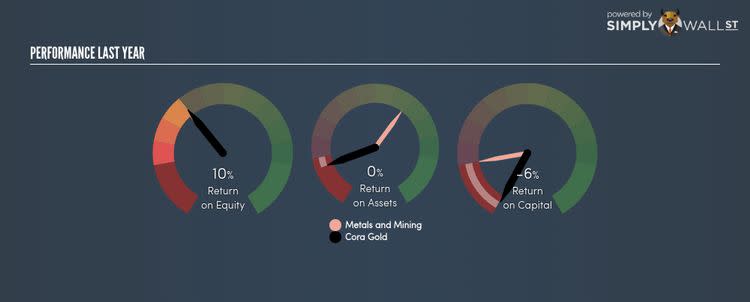With An ROE Of 9.77%, Has Cora Gold Limited’s (AIM:CORA) Management Done A Good Job?

Cora Gold Limited (AIM:CORA) delivered an ROE of 9.77% over the past 12 months, which is an impressive feat relative to its industry average of 9.36% during the same period. Superficially, this looks great since we know that CORA has generated big profits with little equity capital; however, ROE doesn’t tell us how much CORA has borrowed in debt. We’ll take a closer look today at factors like financial leverage to determine whether CORA’s ROE is actually sustainable. View our latest analysis for Cora Gold
Breaking down ROE — the mother of all ratios
Return on Equity (ROE) weighs CORA’s profit against the level of its shareholders’ equity. An ROE of 9.77% implies £0.1 returned on every £1 invested. In most cases, a higher ROE is preferred; however, there are many other factors we must consider prior to making any investment decisions.
Return on Equity = Net Profit ÷ Shareholders Equity
Returns are usually compared to costs to measure the efficiency of capital. CORA’s cost of equity is 10.00%. Since CORA’s return does not cover its cost, with a difference of -0.23%, this means its current use of equity is not efficient and not sustainable. Very simply, CORA pays more for its capital than what it generates in return. ROE can be split up into three useful ratios: net profit margin, asset turnover, and financial leverage. This is called the Dupont Formula:
Dupont Formula
ROE = profit margin × asset turnover × financial leverage
ROE = (annual net profit ÷ sales) × (sales ÷ assets) × (assets ÷ shareholders’ equity)
ROE = annual net profit ÷ shareholders’ equity
The first component is profit margin, which measures how much of sales is retained after the company pays for all its expenses. The other component, asset turnover, illustrates how much revenue CORA can make from its asset base. The most interesting ratio, and reflective of sustainability of its ROE, is financial leverage. Since financial leverage can artificially inflate ROE, we need to look at how much debt CORA currently has. The debt-to-equity ratio currently stands at a low 44.07%, meaning the above-average ROE is due to its capacity to produce profit growth without a huge debt burden.
What this means for you:
Are you a shareholder? CORA exhibits a strong ROE against its peers, however it was not high enough to cover its own cost of equity this year. However, investors shouldn’t despair since ROE is not inflated by excessive debt, which means CORA still has room to improve shareholder returns by raising debt to fund new investments. If you’re looking for new ideas for high-returning stocks, you should take a look at our free platform to see the list of stocks with Return on Equity over 20%.
Are you a potential investor? If CORA has been on your watch list for a while, making an investment decision based on ROE alone is unwise. I recommend you do additional fundamental analysis by looking through our most recent infographic report on Cora Gold to help you make a more informed investment decision.
To help readers see pass the short term volatility of the financial market, we aim to bring you a long-term focused research analysis purely driven by fundamental data. Note that our analysis does not factor in the latest price sensitive company announcements.
The author is an independent contributor and at the time of publication had no position in the stocks mentioned.


